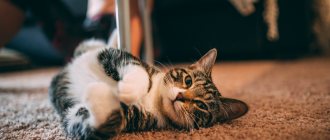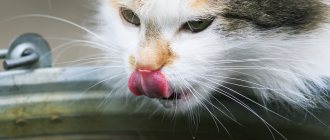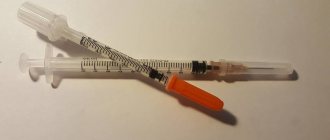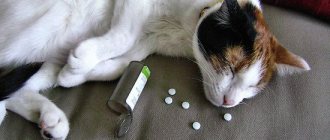Pregnancy of a pet is a joyful and important event. Cats become sexually mature by 6-8 months and, if the owner does not plan to sterilize her, you need to be prepared for childbirth. When a female gives birth for the first time, it is especially exciting.
Nature made sure that cats did everything on their own, but sometimes it needs to be stimulated. Street animals often find a secluded place and do not bother their owners. But helping a cat give birth in a city apartment is often necessary.
How to prepare? What to do when your cat doesn't push well? What drugs should I use? When to see a doctor? What to do if a cat gives birth for the first time? We will answer these and other questions further.
Stages of pregnancy
Short-haired and hairless breeds bear kittens for 55-65 days, long-haired breeds - up to 75 days. Pregnancy time also depends on the number of babies in the womb. The more kittens, the faster the birth will occur. However, if there are 1-2 cubs in the litter, then they can be expected with some delay.
ATTENTION! Sometimes one meeting with a male is not enough. Conception can occur a third or subsequent times, so it is difficult to determine the exact date of pregnancy at home.
Let's trace the stages of pregnancy for clarity:
- By the 20th day, the cat’s nipples become rounded, turn pink, and may peel. The female moves less and avoids high surfaces. He prefers sleep to active games and eats heavily several times a day. The belly increases slightly, but in long-haired breeds this is not noticeable. When palpating, you can feel the developing fetus, but this should be done carefully, because hasty actions will harm both the cat and the baby.
- From day 40, the fetus begins to actively develop. Gradually, limbs, head, and tail are formed. Internal organs are being formed and the nervous system is developing. Subsequently, the fetus acquires features inherent in cats, and also acquires sparse hair. The cat gradually loses its appetite.
- By week 6, the fruits descend into the abdominal cavity and stretch out. The belly is noticeably rounded, but if there are only one or two kittens, the changes are practically invisible. The abdominal cavity increases noticeably and takes the shape of a pear.
- After the 50th day, future kittens move actively. If there are many of them, then there is not enough space for everyone. The cat is experiencing discomfort. The expectant mother experiences vaginal discharge and colostrum appears from the nipples. The pelvis relaxes, and any day now the cat will give birth. She restlessly walks around the apartment or lies for a long time in a pre-prepared nest.
Maine Coon, British, Persian and Sphynx cats often require owner intervention and, in rare cases, veterinary intervention.
Freeing the kitten from the amniotic sac
If the cat has not released the baby from the amniotic sac within one minute after the birth, you need to do the following:
- Quickly cut the bubble.
- Take the newborn out and wrap him in cloth.
- Next, you need to hold the baby’s head and bend his body into an arc so that his knees reach his chest. If you do this several times, the baby will begin to breathe.
- If necessary, remove any remaining amniotic fluid from the mouth and nose with a pipette.
- Rub the baby with a terry towel. If breathing does not appear, perform artificial respiration.
Preparation
Preliminary measures will not be superfluous, although most breeds cope well with pregnancy on their own. So what should you do if your cat gives birth for the first time?
First, we set up a nest. A regular cardboard box is perfect for this. We put a diaper or any other fabric on the bottom for convenience. Experienced owners recommend using several layers of soft paper or baby diapers. Special houses for cats are suitable for nesting. The main thing is that the expectant mother has free access.
Secondly, the cat should build a nest in a warm, ventilated room. We exclude drafts and the presence of other animals. We exclude the toilet and bathroom. The ideal option would be a small room where the cat will not be disturbed. For example, a storage room.
Thirdly, in order for the pet to successfully give birth, it is provided with food and clean drinking water. All this is placed near the nest or place where the cat prefers to sleep. Presumably she will give birth there.
What items will be needed to help the cat, stimulate and speed up the process? The list may change, but if the owner has most of the above, then half the battle is already done:
- Disposable diapers and wet wipes.
- Scissors.
- Disposable syringes and a number of medications to eliminate complications.
- Vaseline oil to stimulate the vaginal muscles.
- Surgical (or silk) thread to tie the umbilical cord.
- Iodine, brilliant green, disinfectants.
Search for a place
A place for a woman in labor can be arranged on a bed or using a tray. The most suitable option is a cardboard box, the bottom of which is covered with paper. Qualities that a birthing place must meet:
- The box should be closed, but large in size, since the animal will live there with the kittens for several months.
- For convenience, one wall of the box is cut off. This will allow the cat to freely enter the bed area without jumping over the barrier each time.
- The prepared house is installed in a quiet place, closed from prying eyes. This could be the bathroom, a corner of the room behind the sofa, or a closet.
If the cat ignored the chosen place and hid in the closet, this is an indicator that it lacks silence and feels unprotected.
Causes of problems
Taking a dip at home is quite easy. It doesn’t matter if it’s a village house or a city apartment. But in some cases, the pregnancy period has passed, and the cat still does not give birth, although all the signs are obvious. The kittens will continue to grow, taking away strength and energy. The larger the fetus, the more difficult the birth will be. They should not be tightened.
Let's list the main reasons why a cat is unable to go into labor on time:
- malposition;
- the kitten is too big;
- narrow pelvis;
- insufficient amount of lubricant;
- incomplete dilatation of the cervix;
- age of the cat;
- mechanical injury;
- inflammation of the genital organs;
- the cat is overweight;
- breed characteristics - dwarf, Himalayan;
- anatomical properties of the vaginal vault.
Weak labor activity stands out. There are two main types. The first is a slight tone of the uterus. It is caused by a lack of the hormone oxytocin. In rare cases, calcium. The second occurs when labor lasts more than a day, the cat has lost a lot of strength and can no longer push.
To avoid the problems described above, a pregnant cat is taken to a veterinarian before giving birth. He conducts examinations and makes recommendations if any of the listed anomalies are detected. In rare cases, hospital observation is required to prevent the death of a cat and its offspring. This could be a clinic in Moscow or a good provincial one.
When to call the vet
During childbirth, critical situations may arise that can only be resolved in a clinical setting. This:
- More than a day has passed since the first contractions;
- it is not possible to independently remove a stuck kitten from the birth canal;
- there are no precursors of the onset of labor, although more than 65-70 days of pregnancy have already passed;
- the cat has a high or, conversely, low body temperature;
- the animal does not strain or move, breathing is weak;
- contractions are strong, but the kitten does not appear;
- unpleasant-smelling contents mixed with pus and blood are released from the birth canal.
Caesarean section during childbirth
How to induce labor at home
It should be understood that there are a large number of drugs on the market. In any case, it is better to consult a veterinarian who will take into account the individual characteristics of the cat. A number of drugs are excellent at inducing and accelerating the birth of your pet.
Let's look at the main medications that are used for stimulation:
- Oxytocin. Perhaps the main drug used in difficult childbirth. However, incorrect dosage can lead to bleeding and cervical rupture. Before use, consultation with a veterinarian is required!
- Traumatin. Used as an analgesic and prophylactic for difficult childbirth. Travmatin is effective in healing wounds with damage to the genital organs. Prevents infection of the uterine cavity by pathogenic microbes.
- Gamavit. Directly stimulates the muscles of the uterus. Often used in prolonged labor and difficult cases.
- Calcium gluconate. A lack of this element often leads to complications along with oxytocin. The drug enhances labor activity as it acts. It also provokes the formation of milk. Used to relieve nervous tension after childbirth.
Lack of calcium leads to the development of eclampsia - acute postpartum depression, which negatively affects the nervous system and causes severe convulsions. In advanced cases it leads to the death of the animal.
Veterinary practice knows cases when labor can be induced without the use of medications. Let us note two main methods.
Option one
The owner puts on gloves. Puts the cat in a position where she goes to the toilet "in large quantities." Next, massage the abdomen in a circular motion. After a couple of minutes, dip your finger in Vaseline oil and insert it into the cat’s vagina about a centimeter. Circular movements are repeated again. Mechanical actions help stimulate and speed up labor.
Option two
When oxytocin is contraindicated for a cat for some reason or the owner does not risk using it, then the following method will come to the rescue. Using a disposable syringe, mix 2 ml of ascorbic acid, 4 ml of glucose, 4 ml of calcium gluconate. We administer intramuscularly or intravenously, but only after the female has given birth to her first baby.
For every 5 kg of weight, 1 ml of the resulting solution is sufficient. It is also used after childbirth as a prophylaxis against eclampsia.
Stages of the procedure
Specialists note several stages that precede the birth of kittens. The cat walks restlessly, the babies are actively moving in the stomach.
The first stage of labor begins. It lasts up to 24 hours. The cat's body temperature drops by 2-3 degrees. This is a natural process. The cat actively licks the nipples or genitals. In some cases, vomiting is observed. It is better to transfer the expectant mother to a previously prepared nest. There she will feel safe and prepared for childbirth.
The cat's water breaks and her pulse quickens. Breathing is occasionally interrupted. The contractions began. The pet meows loudly, sometimes turning into a scream. The owner calms the cat down by talking and lightly stroking the belly.
The second stage begins. The abdominal and diaphragm muscles are activated. The cat is pushing hard and the baby is gradually moving forward. The amniotic sac partially ruptures and fluid flows from the vagina.
Many owners are interested: is a kitten born feet first or head first? In this, cats copy humans. Like a human baby, a kitten is born head first. But it is worth noting that birth with the pelvis or paws forward should not cause concern to the owner. This is natural for cats.
The mother licks the baby, freeing it from the amniotic sac. Cats often eat this afterbirth. It is rich in vitamins and minerals. But a large amount of afterbirth eaten causes indigestion. The optimal quantity for a female is 2 pieces. In most cases, the cat chews the umbilical cord on its own.
ATTENTION! The number of afterbirths exactly corresponds to the number of kittens. Sometimes their number does not match. This means that one of the placentas remained inside the uterus. It must be removed to prevent inflammation of the genital organs in the future.
The final, third stage comes into force. The animal's uterus comes to rest until the next kitten appears. The break between births lasts from 10 to 60 minutes. The cat can drink and rest a bit.
The time of birth is an individual value. But if they continue for more than 24 hours, you should contact your veterinarian.
What happens to a cat after giving birth?
The mother needs time to recuperate after lambing. It is necessary to monitor her condition so as not to miss alarming symptoms.
Normal state
For the first 5-7 hours (sometimes 24 hours), the mother may refuse to eat, which is considered normal if she actively laps up water. Trips to the litter tray may be suspended temporarily (up to 4 days). It is also possible for pink discharge to appear in the first 7 days after birth.
As for when a cat begins to produce milk, the norm is immediately after birth, when the first-born kitten begins to suckle. Minor delays due to stress are acceptable. After a short time, the cat will calm down and lactation will improve. Next, it is necessary to provide the woman in labor with peace, fresh food, and drink so that the milk does not disappear.
Signs of complications
Deterioration of condition after lambing is more often observed in very young, injured and purebred individuals. Domestic cats that are constantly in the fresh air and actively moving have stronger bodies, so difficult childbirth is practically excluded.
Pet owners need to monitor behavior to spot adverse symptoms early.
You should consult a doctor if you experience any of the following symptoms:
- the cat is anxious, restless or apathetic;
- no appetite for more than 24 hours;
- body temperature changed sharply: increased to 39.4 °C or fell below 36.1 °C;
- bleeding continues for more than 10 minutes;
- milk of abnormal color and/or consistency (yellowish, transparent, curdled);
- persistent vomiting and/or diarrhea;
- paws and/or head trembling;
- purulent or foul-smelling discharge within 3 weeks after birth;
- nipples are very hot and swollen;
- The cat doesn't care about kittens.
In females with very large offspring, milk fever (eclampsia) may develop due to a sharp decrease in calcium concentration in the body.
Signs of pathology in a cat:
- anxiety;
- rapid breathing;
- pallor of the mucous membranes;
- lack of coordination of movements;
- pointed muzzle with exposed fangs;
- temperature jump to 41.1 °C;
- convulsions, loss of consciousness.
What kind of help will you need?
So, we figured out how to induce and stimulate labor. But in some cases complications may occur. You will need the owner's help. Let's look at the most common cases and specific actions. It is especially useful for people to know when a cat gives birth for the first time:
The fetus is large and does not pass through the uterus
We have found that it is preferable for a kitten to be born head first. There is nothing wrong with walking feet first, but it often causes complications for the cat. What to do if the fruit is large?
We put on gloves, having previously lubricated our fingers with Vaseline oil. We insert a finger into the vagina and feel the folds of the kitten’s paws. We move the baby from side to side, trying to stretch the limbs forward. We grab the paws in the area of the shoulder joint.
Sometimes the baby is far from the exit of the uterus. We provoke contractions in the cat by stretching the vagina.
The cat did not chew the umbilical cord
It is worth waiting 10-15 minutes; if the woman in labor does not take any action, then you need to help her. We squeeze the umbilical cord with two or three fingers at a distance of 3-4 centimeters from the kitten’s belly. We tie it with silk or surgical thread. We take sterile scissors in our hands. Surgical ones are better. We cut the umbilical cord. We treat the cut site with an antiseptic.
The kitten is not released from the amniotic sac
We wait one or two minutes and cut it ourselves. We take out the kitten and wrap it in cloth. We hold our head and bend our body so that our knees reach our chests. We perform the manipulations several times. Breathing should resume. If it does not appear, then perform artificial respiration. If necessary, remove amniotic fluid from the nose and ears with a pipette.
Kittens are still born
It’s a scary situation, but we don’t lose our composure. Sometimes severe contractions, low temperature or an abundance of mucus in the nasal cavity lead to the fact that the kitten only appears dead. We dry the baby. We clear the airways, turn the head down and gently shake. Next we put it on the mother’s chest.
The cat definitely gives birth to dead pets one after another. We palpate the female's belly. If one or two fetuses are felt, then immediately contact the veterinarian. A caesarean section may be required.
Can't give birth
If the female pushes weakly, then we use oxytocin, calcium gluconate or a solution of ascorbic acid and glucose. If the drugs do not help, then immediately contact the veterinarian. Resuscitation may be required.
The cat may bleed. If it continues for a long time, you should contact your veterinarian. The same applies to unpleasant vaginal discharge. There should be no sudden drop or rise in temperature.
If contractions last more than two hours, but labor has not begun, contact the clinic. This could be Moscow or any other city. It happens that two fruits try to pass at once.
Especially during the first birth, it is better not to take risks and seek help from specialists. Any complication will negatively affect the pet’s health. To the point of being unable to give birth again.
We use medications only after consultation with a veterinarian. It is good if another family member or friend provides assistance during childbirth.
Signs that indicate the onset of labor
1–3 days before the onset of labor, you can understand from the cat’s behavior that this moment will soon come:
- The future tailed mother is actively looking for secluded places, every now and then trying to hide in the closet or behind the sofa. Digs there, trying to build a nest. The pet becomes very affectionate, constantly demands attention, and can sometimes be annoying. It rarely happens that a cat, on the contrary, becomes overly aggressive and hides from its owners. Other symptoms:
- at this time, the loop increases greatly, and clear or light pink discharge is observed;
the cat begins to lick itself more often;
- There is a loss of appetite up to complete refusal of food.
- When there are a day or a little less left before lambing, the animal’s body temperature drops to 37°C.
- 4–8 hours before lambing, the animal begins to hunch over. This is how the body reacts to training contractions of the uterus. This process causes great anxiety in the pet; she may complain to the owner, seeking his support. But another option is also possible - she will try to hide.
- 4 hours before labor, the mucus plug comes off. It is a small transparent clot, sometimes it can have a yellowish or greenish tint and include small inclusions of brown, which is considered normal. Often the plug comes out during urination or in parts. But this moment may not be noticed in an overly clean animal.
- When the temperature rises to normal—38–39°C—this means that there are about 2 hours left before birth.
1–3 days before giving birth, the cat persistently demands attention and affection
If a cat experiences premature lambing, then the described symptoms occur almost 2 times faster.
Call a veterinarian immediately if:
- a furry pet carries kittens longer than expected;
- the pet experiences fever, vomiting and convulsions;
- bleeding lasts more than 10 minutes and is accompanied by an unpleasant odor.
Video: signs of the beginning of lambing
Premature birth
Sexual infections, physical trauma, and severe stress are some of the main causes of premature lambing. This problem can occur in older cats or in representatives of breeding and selective breeds who are giving birth for the first time.
Be sure to show your pregnant cat to a veterinarian, and before giving birth, agree with him about help if necessary.
If lambing occurs when the gestation period is 51 days or more, the kittens are considered viable and must be fought for their lives. Call your veterinarian immediately. But under no circumstances try to stop contractions in order to postpone labor until a specialist arrives. You will have to deliver the baby yourself.
If the premature birth was successful and the cat feels fine, still show her to a specialist.
How to behave with a pet
If this is your first time attending the birth of a family pet, then excitement is a natural process. You must understand that when a furry mother goes into labor, she experiences pain, fear and needs support. Your behavior will largely determine the successful outcome of the case. Even if you don’t really understand how to act, control yourself. Get together and provide all possible assistance:
- Try to ensure that no strangers or curious people gather near the lambing area.
- Apart from the owner, there should be no other people in the cat's field of vision, even if they are family members to whom the cat is accustomed.
- Talk kindly to your pet, show her that you are nearby and will not abandon her in difficult times. Stroke it from top to bottom. Speak kind words.
Your participation will calm the cat before giving birth











